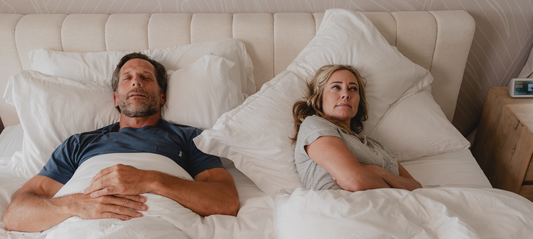Written by Scott Baylon
August 24, 2023
Does size matter?
Yes. Well, your neck size does when it comes to sleep apnea.
Obstructive sleep apnea (OSA) is a sleep disorder that affects millions, causing interruptions in breathing during sleep. While the factors contributing to OSA are multifaceted, neck circumference is an often-overlooked risk indicator. A neck circumference greater than 16 inches for women or 17 inches for men can be a red flag for potential OSA. In this article, we explore the correlation between neck circumference and sleep apnea, shedding light on why this measurement matters and providing step-by-step instructions for accurate measurement.
The Neck Circumference and OSA Link:
The muscles at the back of your throat play a crucial role in maintaining an open airway during sleep. However, in individuals with OSA, these muscles relax excessively, leading to partial or complete airflow blockage. A larger neck circumference can contribute to this obstruction by exerting pressure on the airway, making it more prone to collapse. As a result, assessing neck circumference serves as an important tool in identifying those at risk for OSA and prompting necessary interventions.
Step-by-Step Guide to Measuring Neck Circumference:
-
Gather Materials: You'll need a flexible measuring tape, which can be found at most stores or online.
-
Prepare for Measurement: Stand in front of a mirror in a relaxed posture. Keep your head straight, shoulders down, and feet planted on the ground.
-
Locate Midpoint: Gently press your fingers against the side of your neck to locate the midpoint, situated between your Adam's apple and the base of your neck.
-
Wrap the Measuring Tape: Hold the measuring tape around your neck, just below your Adam's apple. Make sure the tape is parallel to the floor and positioned snugly, but not too tight.
-
Read the Measurement: Ensure the tape is level and note the measurement where the end of the tape meets the rest of it. Read the measurement in inches or centimeters, depending on your preferred unit.
-
Record the Measurement: Write down the recorded measurement accurately. Double-check the number to ensure precision.
Conclusion:
Measuring neck circumference might seem like a simple step, but it holds valuable insights into your risk for obstructive sleep apnea. A neck circumference greater than 16 inches for women or 17 inches for men is a risk factor that should not be ignored. By recognizing the connection between neck size and OSA and following our step-by-step guide, you can take a proactive step towards understanding your sleep health. If you suspect you might be at risk for OSA, it's advisable to consult a medical professional or sleep specialist for further evaluation and guidance. Remember, knowledge is power, and being informed about your health can lead to a path of better sleep and improved well-being.










































